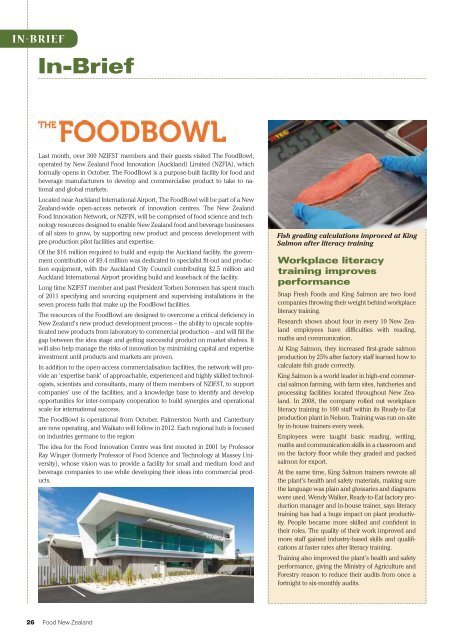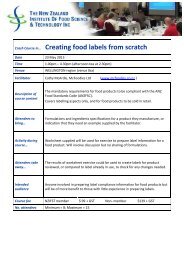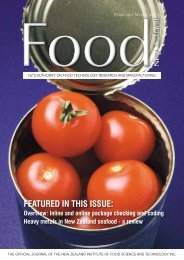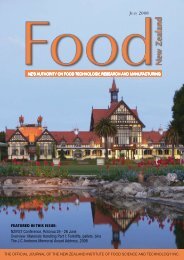featured in this issue - NZIFST - The New Zealand Institute of Food ...
featured in this issue - NZIFST - The New Zealand Institute of Food ...
featured in this issue - NZIFST - The New Zealand Institute of Food ...
Create successful ePaper yourself
Turn your PDF publications into a flip-book with our unique Google optimized e-Paper software.
IN-BRIEF<br />
In-Brief<br />
Last month, over 300 <strong>NZIFST</strong> members and their guests visited <strong>The</strong> <strong>Food</strong>Bowl,<br />
operated by <strong>New</strong> <strong>Zealand</strong> <strong>Food</strong> Innovation (Auckland) Limited (NZFIA), which<br />
formally opens <strong>in</strong> October. <strong>The</strong> <strong>Food</strong>Bowl is a purpose-built facility for food and<br />
beverage manufacturers to develop and commercialise product to take to national<br />
and global markets.<br />
Located near Auckland International Airport, <strong>The</strong> <strong>Food</strong>Bowl will be part <strong>of</strong> a <strong>New</strong><br />
<strong>Zealand</strong>-wide open-access network <strong>of</strong> <strong>in</strong>novation centres. <strong>The</strong> <strong>New</strong> <strong>Zealand</strong><br />
<strong>Food</strong> Innovation Network, or NZFIN, will be comprised <strong>of</strong> food science and technology<br />
resources designed to enable <strong>New</strong> <strong>Zealand</strong> food and beverage bus<strong>in</strong>esses<br />
<strong>of</strong> all sizes to grow, by support<strong>in</strong>g new product and process development with<br />
pre-production pilot facilities and expertise.<br />
Of the $16 million required to build and equip the Auckland facility, the government<br />
contribution <strong>of</strong> $9.4 million was dedicated to specialist fit-out and production<br />
equipment, with the Auckland City Council contribut<strong>in</strong>g $2.5 million and<br />
Auckland International Airport provid<strong>in</strong>g build and leaseback <strong>of</strong> the facility.<br />
Long time <strong>NZIFST</strong> member and past President Torben Sorensen has spent much<br />
<strong>of</strong> 2011 specify<strong>in</strong>g and sourc<strong>in</strong>g equipment and supervis<strong>in</strong>g <strong>in</strong>stallations <strong>in</strong> the<br />
seven process halls that make up the <strong>Food</strong>Bowl facilities.<br />
<strong>The</strong> resources <strong>of</strong> the <strong>Food</strong>Bowl are designed to overcome a critical deficiency <strong>in</strong><br />
<strong>New</strong> <strong>Zealand</strong>’s new product development process – the ability to upscale sophisticated<br />
new products from laboratory to commercial production – and will fill the<br />
gap between the idea stage and gett<strong>in</strong>g successful product on market shelves. It<br />
will also help manage the risks <strong>of</strong> <strong>in</strong>novation by m<strong>in</strong>imis<strong>in</strong>g capital and expertise<br />
<strong>in</strong>vestment until products and markets are proven.<br />
In addition to the open-access commercialisation facilities, the network will provide<br />
an ‘expertise bank’ <strong>of</strong> approachable, experienced and highly skilled technologists,<br />
scientists and consultants, many <strong>of</strong> them members <strong>of</strong> <strong>NZIFST</strong>, to support<br />
companies’ use <strong>of</strong> the facilities, and a knowledge base to identify and develop<br />
opportunities for <strong>in</strong>ter-company cooperation to build synergies and operational<br />
scale for <strong>in</strong>ternational success.<br />
<strong>The</strong> <strong>Food</strong>Bowl is operational from October. Palmerston North and Canterbury<br />
are now operat<strong>in</strong>g, and Waikato will follow <strong>in</strong> 2012. Each regional hub is focused<br />
on <strong>in</strong>dustries germane to the region<br />
<strong>The</strong> idea for the <strong>Food</strong> Innovation Centre was first mooted <strong>in</strong> 2001 by Pr<strong>of</strong>essor<br />
Ray W<strong>in</strong>ger (formerly Pr<strong>of</strong>essor <strong>of</strong> <strong>Food</strong> Science and Technology at Massey University),<br />
whose vision was to provide a facility for small and medium food and<br />
beverage companies to use while develop<strong>in</strong>g their ideas <strong>in</strong>to commercial products.<br />
Fish grad<strong>in</strong>g calculations improved at K<strong>in</strong>g<br />
Salmon after literacy tra<strong>in</strong><strong>in</strong>g<br />
Workplace literacy<br />
tra<strong>in</strong><strong>in</strong>g improves<br />
performance<br />
Snap Fresh <strong>Food</strong>s and K<strong>in</strong>g Salmon are two food<br />
companies throw<strong>in</strong>g their weight beh<strong>in</strong>d workplace<br />
literacy tra<strong>in</strong><strong>in</strong>g.<br />
Research shows about four <strong>in</strong> every 10 <strong>New</strong> <strong>Zealand</strong><br />
employees have difficulties with read<strong>in</strong>g,<br />
maths and communication.<br />
At K<strong>in</strong>g Salmon, they <strong>in</strong>creased first-grade salmon<br />
production by 25% after factory staff learned how to<br />
calculate fish grade correctly.<br />
K<strong>in</strong>g Salmon is a world leader <strong>in</strong> high-end commercial<br />
salmon farm<strong>in</strong>g, with farm sites, hatcheries and<br />
process<strong>in</strong>g facilities located throughout <strong>New</strong> <strong>Zealand</strong>.<br />
In 2008, the company rolled out workplace<br />
literacy tra<strong>in</strong><strong>in</strong>g to 100 staff with<strong>in</strong> its Ready-to-Eat<br />
production plant <strong>in</strong> Nelson. Tra<strong>in</strong><strong>in</strong>g was run on-site<br />
by <strong>in</strong>-house tra<strong>in</strong>ers every week.<br />
Employees were taught basic read<strong>in</strong>g, writ<strong>in</strong>g,<br />
maths and communication skills <strong>in</strong> a classroom and<br />
on the factory floor while they graded and packed<br />
salmon for export.<br />
At the same time, K<strong>in</strong>g Salmon tra<strong>in</strong>ers rewrote all<br />
the plant’s health and safety materials, mak<strong>in</strong>g sure<br />
the language was pla<strong>in</strong> and glossaries and diagrams<br />
were used. Wendy Walker, Ready-to-Eat factory production<br />
manager and <strong>in</strong>-house tra<strong>in</strong>er, says literacy<br />
tra<strong>in</strong><strong>in</strong>g has had a huge impact on plant productivity.<br />
People became more skilled and confident <strong>in</strong><br />
their roles. <strong>The</strong> quality <strong>of</strong> their work improved and<br />
more staff ga<strong>in</strong>ed <strong>in</strong>dustry-based skills and qualifications<br />
at faster rates after literacy tra<strong>in</strong><strong>in</strong>g.<br />
Tra<strong>in</strong><strong>in</strong>g also improved the plant’s health and safety<br />
performance, giv<strong>in</strong>g the M<strong>in</strong>istry <strong>of</strong> Agriculture and<br />
Forestry reason to reduce their audits from once a<br />
fortnight to six-monthly audits.<br />
26<br />
<strong>Food</strong> <strong>New</strong> <strong>Zealand</strong>

















